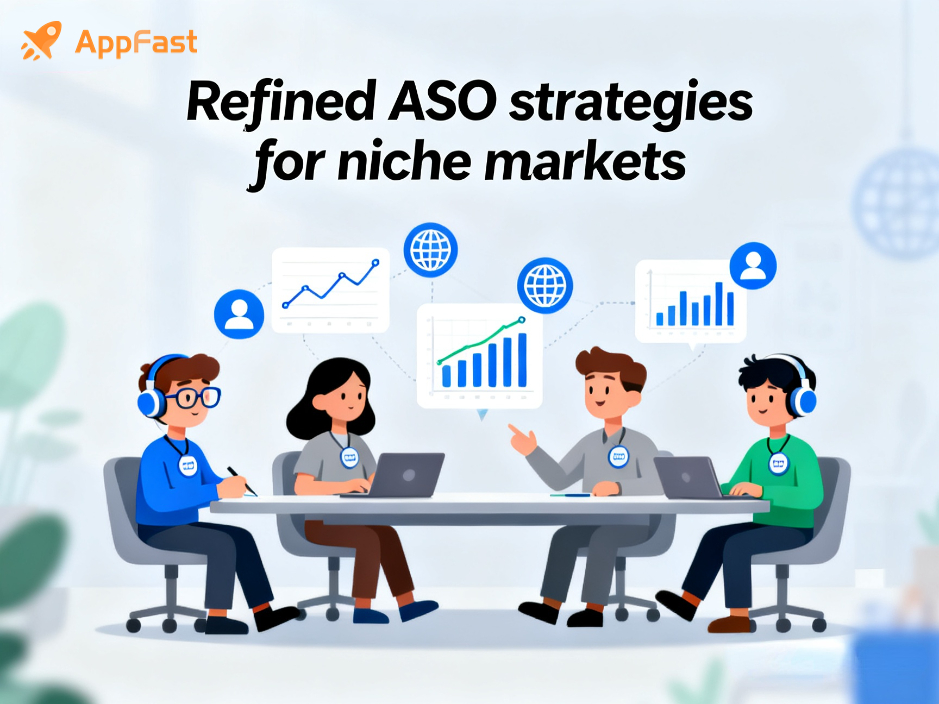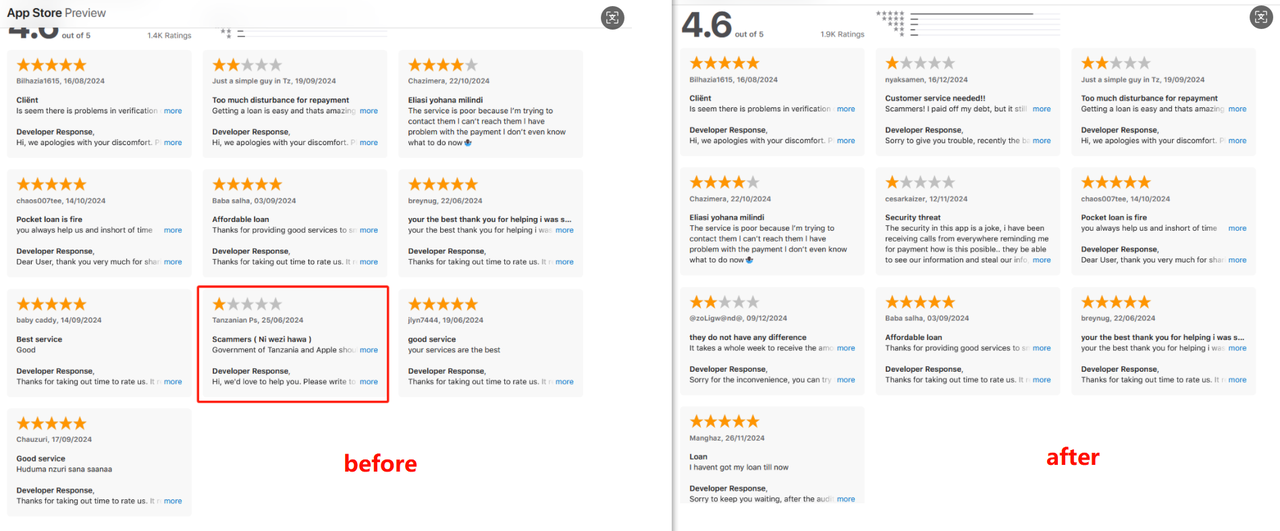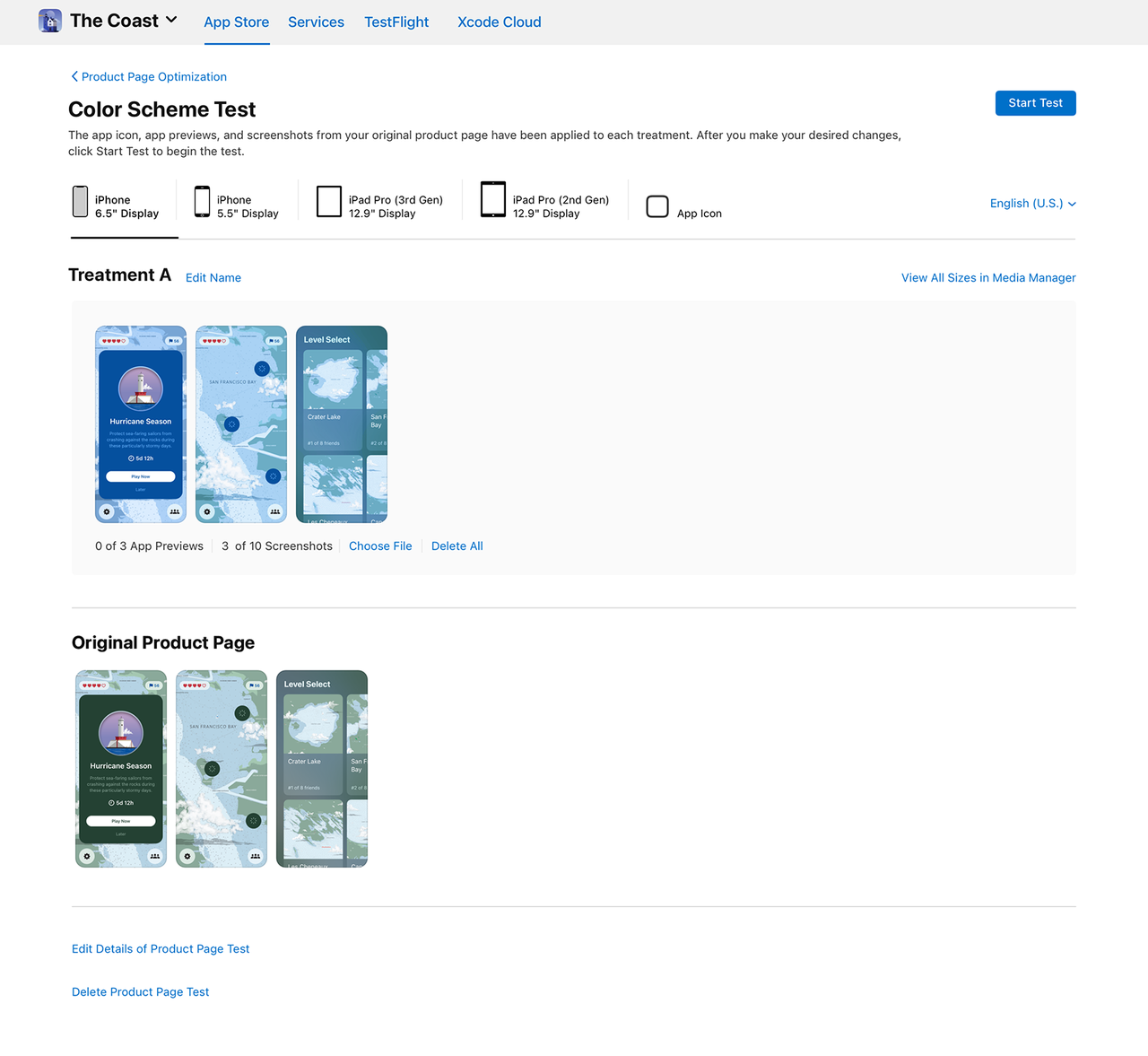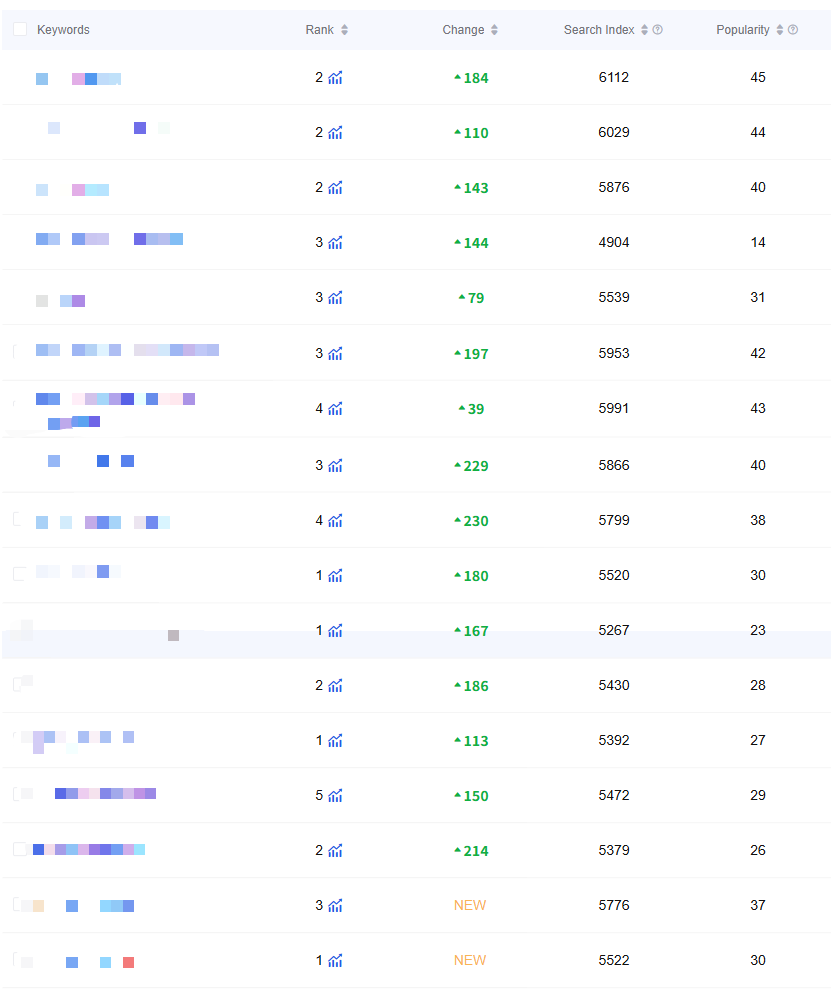Free consultation with ASO specialists
Doing ASO for the first time or have no idea how to carry out targeted optimization of your app?
We offer one-on-one customized services provided by app marketing specialists
Breaking Through with New Vertical Domain Apps: A Refinement ASO Strategy for Niche Markets
2025-09-28

Discover how new vertical-market apps can break through in niche markets with refined ASO strategies. This article details seven practical strategies, including keyword optimization, metadata enhancement, and localized operations, and shares successful case studies. Get your professional guide now to boost your app's visibility and downloads in app stores.
Opportunities and Challenges for Vertical Domain Apps
The current mobile app market is becoming increasingly saturated, but there are still significant opportunities in vertical niche apps. These apps focus on specific industries or niche audiences, and through highly personalized experiences and precise targeting, they can effectively gain the trust of their target users and establish a differentiated competitive advantage. The key to success for these apps lies in personalized experiences and precise targeting, which allow them to quickly earn the trust and positive word-of-mouth from their target users.
However, vertical apps also face unique challenges: limited user base, requiring greater emphasis on user quality and conversion rates; complex keyword competition, necessitating a balance between popular and long-tail keywords; and low brand awareness, resulting in insufficient store visibility. Therefore, vertical apps need to adopt a refined ASO strategy, enhancing exposure and conversion efficiency through precise keyword placement, optimized metadata, and localized operations.
ASO Strategies for Vertical Domain Apps
ASO for vertical-domain apps requires customized optimization tailored to the characteristics of niche markets. Below is a set of proven, refined ASO strategies that cover keyword selection, metadata optimization, user Reviews, localized operations, competitor analysis, A/B testing, and tool utilization.
-
Lock in precise keywords
Keyword optimization is a core component of ASO, especially crucial for apps in vertical markets. To achieve effective exposure and precise customer acquisition, it is recommended to systematically carry out keyword optimization work from the following aspects:
-
Leveraging tools and data research: Use ASO tools (such as UPUP) to analyze high-frequency industry keywords and competitor keywords, and combine this with user search suggestions and feedback Reviews to extract genuine query terms, thereby establishing a preliminary keyword database.
-
Focus on long-tail keywords and scenario-based keywords: Avoid highly competitive generic keywords, and instead prioritize long-tail keywords and vertical scenario keywords with clear search intent and close relevance to your product. For example, a yoga app could target "prenatal yoga" or "lazy face yoga." These types of keywords have high conversion rates and can precisely attract your target users.
-
Adaptable to different store rules: For example, the App Store can fully utilize the 100-character keyword field and appropriately insert core keywords; Google Play can naturally incorporate keywords into the title and description. It is necessary to ensure both user browsing experience and algorithm friendliness.
-
Continuous Iteration and Hotspot Response: Regularly track industry developments and technology trends using tools such as Google Trends, promptly incorporate emerging hot keywords into metadata, keep keyword strategies up-to-date, and attract trend-driven traffic.
If keyword research is giving you trouble, AppFast can do it for you.Offer free customized keyword library servicesOur ASO experts will tailor a high-conversion keyword strategy for you based on your app's characteristics, helping to boost your app store rankings.
-
Optimize application metadata
App metadata is the user's first impression of the app and directly affects the download conversion rate. Vertical-domain apps need to optimize metadata systematically to clearly convey the product's core value and distinctive features. It is recommended to start from the following aspects:
-
Name and subtitle optimization
-
The name should be short and easy to remember, incorporating core keywords and clearly indicating the core functionality.
-
The subtitle should include core scenario keywords and selling points, balancing search matching with user communication.
-
-
Description writing strategy
-
The introduction should quickly capture users' attention and clarify the core value. It is recommended to address users' pain points or highlight key features in the first sentence.
-
Structure it with bullet points to list features and advantages, enhancing readability and avoiding lengthy paragraphs;
-
Naturally incorporate keywords not covered by the title, avoiding keyword stuffing and ensuring the sentences remain smooth and persuasive.
-
Appropriately showcase professional endorsements (such as certifications, user case studies) or features tailored for specific groups to enhance trust.
-
-
Icon and Visual Material Design
-
The icon should be simple and eye-catching, aligning with the aesthetic preferences of the target users. For example, business-oriented apps should adopt a minimalist style, while apps targeting younger audiences should use lively designs.
-
Incorporate elements or metaphors related to the vertical domain to help users quickly identify the app type;
-
Screenshots should clearly showcase the core interface and features, accompanied by concise text to highlight the scenario solutions.
-
Adding preview videos whenever possible to visually demonstrate the usage process and experience can effectively improve conversion rates.
-
-
Improve user Ratings and retention
User Ratings and Reviews significantly influence store rankings and users' download decisions, which is especially crucial for vertical-domain apps. Good word-of-mouth can not only bring high-conversion traffic but also help improve search rankings. User retention is also an important metric evaluated by store algorithms, forming, together with Reviews, the core component of ASO optimization. It is recommended to systematically improve from the following aspects:
-
Strengthen product experience and enhance user satisfaction.
-
Deeply understand the needs of vertical users, continuously optimize product features, performance, and user experience, address core pain points, and build a foundation for spontaneous positive Ratings.
-
-
Set up an appropriate evaluation guidance mechanism
-
Naturally and infrequently prompt for Ratings after users complete key tasks or have positive experiences, avoiding disruption to users;
-
Target loyal users through channels such as communities and emails to share their usage experiences, thereby strengthening word-of-mouth promotion.
-
-
Effectively manage and respond to user Reviews
-
Actively respond to all Reviews: Thank you for the positive Ratings, and sincerely address and resolve issues raised in negative Reviews.
-
Demonstrate an image of valuing user feedback and continuous improvement, enhancing the trust of potential users.
-
-
Implement a comprehensive strategy to enhance user retention
-
Design a new user onboarding flow to lower the entry barrier;
-
Maintain long-term user engagement through regular content updates, feature iterations, and event planning;
-
Build a user community to enhance the sense of belonging and stickiness;
-
High retention not only helps improve Ratings, but also creates a positive cycle of activity - positive Reviews - growth.
-
If your app is struggling with low Ratings or insufficient Reviews, AppFast can provide you with professional Ratings optimization analysis and strategic recommendations. Our services include review feedback analysis, highlighting positive Reviews with likes, and removing negative Reviews with dislikes, helping you effectively improve your app's reputation in app stores. Act nowContact the official website customer serviceGet a consultation!

-
Localization and Regional Optimization
If vertical-apps plan to expand into multiple regional markets, localization is key to ASO success. It is necessary to systematically customize store listings for different languages, cultures, and policy environments, in order to enhance user awareness and conversion intent in each region. Specifically, progress can be made in the following areas:
-
Language and Keyword Localization
-
Provide professional translations for names, subtitles, descriptions, and screenshot text, avoiding literal translations and focusing on local expressions to ensure naturalness and fluency.
-
Study the high-frequency search terms of local users and incorporate them into your keyword strategy; you can use ASO tools or conduct local market research to obtain authentic corpus data.
-
-
Cultural Adaptation and Content Optimization
-
Adjust promotional focuses based on regional cultures. For example, health-related apps can emphasize data privacy in Europe and America, while highlighting the concept of family health in Asia.
-
Visual materials (such as icons, screenshots, and videos) should align with local aesthetics and use scenarios and character images that resonate with local users' perceptions.
-
Enhance resonance through localized content, such as showcasing local cases, festival themes, or region-specific features.
-
-
Policy and store environment adaptation
-
Understand the review rules and categorization requirements of stores in the target country, and ensure compliance in your descriptions.
-
Pay attention to local promotion policies and event opportunities, and actively participate in regional store recommendations or special events.
-
-
Phased implementation strategy
-
Prioritize markets with a large user base and high product fit for in-depth localization.
-
Validate the conversion effect through small-scale testing, gradually expand to more regions, control investment risks, and improve ROI.
-
Not sure if your metadata is performing at its best? AppFast now offers a free metadata diagnostic service. Our expert team will thoroughly analyze the issues with your existing page and provide specific optimization recommendations to help you improve your page conversion rate.
-
Competitor Analysis and Differentiated Positioning
Competitor analysis is an important foundation for vertical-apps to formulate ASO strategies and achieve differentiated breakthroughs. By systematically studying competitors' optimization methods and user Reviews, we can clarify our own optimization direction and create unique selling points. Specifically, this can be approached from the following aspects:
-
Clarify the competitive landscape and select competing products.
-
Select apps with top Ratings, high download volumes, or significant user overlap in the vertical domain as primary competitors;
-
Use ASO tools (such as UPUP) to systematically track competitors' keyword strategies, metadata settings, and visual asset presentation methods.
-
-
Analyze competitors' ASO strategies and user Reviews
-
Regarding keywords: Identify high-value keywords covered by competitors and their ranking positions, and discover potential keyword opportunities that they have not yet targeted.
-
Metadata and Materials: Pay attention to how competitors express themselves and emphasize selling points in titles, descriptions, screenshots, and videos;
-
User Reviews: Focus on analyzing users' positive feedback and common complaints about competitors, extracting key functional requirements and pain points as a basis for our own optimization.
-
-
Shape a differentiated positioning and highlight unique selling points.
-
Based on competitor analysis, clearly identify your core strengths and establish unique selling points.
-
Repeatedly emphasize this differentiated positioning in metadata and visual presentation, enabling target users to quickly recognize the product's value.
-
-
Backfeeding Keyword and Content Strategy
-
Avoid blindly following competitors' keywords; instead, prioritize selecting niche terms with lower competition and high relevance.
-
Supplement the application scenarios or feature keywords that competitors have overlooked, covering a wider range of user search intentions.
-
-
Continuous tracking and dynamic adjustment
-
Competitor strategies change over time, so it's necessary to regularly update analytical conclusions to ensure the timeliness and relevance of the strategy.
-
-
Make full use of A/B testing
A/B testing is a key method for implementing refined ASO. By comparing the effectiveness of different store page elements, you can data-drivenly optimize conversion rates. Specific operational recommendations are as follows:
-
Testing Platform and Tool Support
-
Apple's App Store offers Product Page Optimization (PPO) features, supporting A/B testing of elements such as icons, screenshots, videos, and descriptions.
-

-
Google Play can release different versions of creatives through Alpha/Beta channels, or use third-party ASO platforms to conduct testing.
-
Testing Principles and Design Highlights
-
Test only one variable at a time (e.g., change only the icon while keeping other elements unchanged) to ensure that the results can be attributed;
-
Vertical domain app user groups are well-defined, and test results are more representative, which helps in precisely optimizing the target user experience.
-
-
Examples of common testing scenarios
-
Icons: Compare the impact of different styles or color schemes on click-through rates;
-
Screenshots: Test the impact of different sequences, copy annotations, or scene presentations on conversion rates;
-
Title/Subtitle: Verify whether keyword combinations or expressions can boost search rankings and clicks;
-
Description: Evaluate the impact of different structures or highlighted selling points on user dwell time and download conversion rates.
-
-
Continuous Iteration and Effect Tracking
-
Establish a regular testing mechanism to adapt to changes in market and user preferences;
-
Even a small increase in conversion rate (such as 5%-10%) can lead to significant download growth in vertical markets.
-
Through systematic A/B testing, page performance can be gradually optimized, creating a closed loop of continuous improvement.
-
With the help of tools and professional services
Making good use of professional tools and services is an important support for improving ASO efficiency and achieving precise optimization, especially for App teams in niche vertical fields with limited resources. Here are some specific implementation suggestions:
-
Select ASO tools reasonably to assist analysis
-
Use comprehensive platforms (such as UPUP) to obtain market trends, competitor dynamics, and ranking data;Excavation long-tail keywords and track keyword performance;
-
-
Introduce professional ASO services at the right time.
-
If the team lacks experience or wants quick results, they can entrust the task to an ASO service provider with vertical industry case studies (such as AppFast);
-
Professional agencies can provide customized strategies, covering market research, keyword planning, page optimization, and performance tracking.
-
-
Maintain internal collaboration and strategy-driven approach
-
Regularly review data feedback and continuously adjust and optimize the direction based on your understanding of the product.
-
Organically integrate tool data, external expertise, and internal user insights to build a systematic ASO operational process.
-
Want to systematically improve your keyword rankings? AppFast's keyword installation service has helped hundreds of vertical apps achieve ranking breakthroughs. WelcomeContact Usadvisor to get a personalized promotion plan.

Concluding remarks
For new vertical-domain apps to break through in a highly competitive market, they must shift from extensive promotion to refinement、systematic ASO operations. By effectively integrating keyword strategies, metadata optimization, user Reviews management, localization adaptation, competitor analysis, A/B testing, and tool support, even niche apps can significantly enhance their store visibility and download conversion rates.
ASO is a continuous iterative process, not a one-time task. App store algorithms, user behavior, and industry trends are constantly evolving, requiring the establishment of a normalized monitoring and optimization mechanism. Regularly reviewing data, tracking competitors, and promptly adjusting strategies are essential to maintaining competitiveness.
Adhere to refinement operation and build barriers in vertical domains. Through long-term, focused ASO practices, gradually accumulate user trust and product reputation, forming a sustainable competitive advantage in niche markets.
Related recommendations

